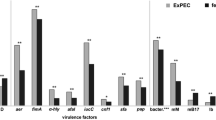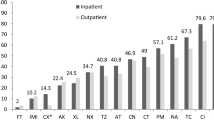Summary
In 50Escherichia coli strains obtained from the bladder puncture urine of patients with chronic pyelonephritis, determinations of virulence properties were performed. All of theE. coli strains isolated from 26 acute episodes of pyelonephritis were found in the smooth form. 30% possessed K 1 antigen, 77% showed the ability to form hemolysin and 30% produced colicin V (aerobactin). Fimbriae (detected by mannose-resistant hemagglutination) were registered in 81%, and plasmids ranging between 50 and 70 Md were demonstrated in 70% of the bacteria. In contrast to this, only 70% of theE. coli strains isolated from 24 patients at an inactive stage of pyelonephritis were found in the smooth form; 10% of these encoded K 1 antigen, 20% hemolysin and 10% colicin V. Plasmids in the range 50 to 70 Md could be found in 30%. On the basis of multivariate analysis of variance and discriminant analysis, it was confirmed that uropathogenic strains possess several virulence properties, mannose-resistant hemagglutination being of particular importance.
Zusammenfassung
Bei 50Escherichia coli-Stämmen, die aus dem Blasenpunktionsurin von Patienten mit chronischer Pyelonephritis gewonnen wurden, erfolgten Bestimmungen ihrer Virulenzeigenschaften. In den 26 Fällen mit einer akuten Erkrankung fanden sich ausschließlich S-Formen der Bakterien, K 1 Antigen wurde in 30% nachgewiesen, 77% verfügten über die Fähigkeit zur Hämolysinbildung und 30% über die zur Colicin V (Aerobactin)-Produktion. In 70% fanden sich Plasmidspezies der Größe zwischen 50 und 70 Md. Demgegenüber wurden bei den 24 Patienten mit einem inaktiven Stadium der Pyelonephritis nur in 70% derE. coli-Stämme S-Formen gefunden. Bei ihnen konnten in 10% K 1 Antigen, in 20% Hämolysin und in 10% Colicin V bestimmt werden. Plasmide zwischen 50 und 70 Md. lagen in 30% der Bakterienstämme vor. Nach der multivariaten Varianz- und Diskriminanzanalyse bestätigt sich, daß uropathogene Bakterienstämme über mehrere Virulenzeigenschaften verfügen müssen, dabei kommt der Fähigkeit zur mannoseresistenten Hämagglutination eine besondere Bedeutung zu.
Similar content being viewed by others
Literature
Glynn, A. A., Brumfitt, W., Howard, C. J. K antigen ofEscherichia coli and renal involvement in urinary tract infections. Lancet I (1977) 514–516.
Kaijser, B. Immunology ofEscherichia coli: K antigen and its relation to urinary tract infections. J. Infect. Dis. 127 (1973) 670–672.
Bjorksten, B., Kaijser, B. Interaction of human serum and neutrophils withEscherichia coli strains, differences between strains isolated from urine of patients with pyelonephritis of asymptomatic bacteriuria. Infect. Immun. 22 (1978) 308–311.
Minshew, B. H., Jorgensen, J., Swanstrum, M., Grootes-Reuvencamp, G. A., Falkow, S. Some characteristics ofEscherichia coli strains isolated from extraintestinal infections of humans. J. Infect. Dis. 137 (1978) 645–647.
Bosch, J. F. van den, Postma, P., Koopman, P. A., De Graeff, J., MacLaren, D. M. Virulence of urinary and faecalEscherichia coli in relation to serotype, haemolysis and haemagglutination. J. Hyg., Camb. 88 (1982) 567–577.
Davies, D. L., Falkiner, F. R., Hardy, K. G. Colicin V production by clinical isolates ofEscherichia coli. Infect. Immun. 31 (1981) 574–579.
Dijk, W. C. van, Verbrugh, H. A., Poters, R., van der Tol, M. E., Peterson, P. K., Verhoff, I. Escherichia coli K antigen in relation to serum-induced lysis and phagocytosis. J. Med. Microbiol. 10 (1977) 123–130.
Green, C. P., Thomas, V. L. Hemagglutination of human type O erythrocytes, hemolysin production and serogrouping ofEscherichia coli isolates from patients with acute pyelonephritis, cystitis and asymptomatic bacteriuria. Infect. Immun. 31 (1981) 309–315.
Hacker, J., Schröter, G., Schrettenbrunner, A., Hughes, C., Goebel, W. HemolyticEscherichia coli strains in the human fecal flora as potential urinary pathogens. Zbl. Bakt. Hyg. I, Abt. Orig. A 729 (1983) 1–9.
Hanson, L. A., Ahlstedt, S., Fasth, A., Jobal, U., Kaijser, B., Larsson, P., Lindberg, U., Olling, S., Sohl-Akerlund, A., Svanborg Edén, C. Antigens ofEscherichia coli, human immune response and the pathogenesis of urinary tract infections. J. infect. Dis. 136 (1977) 144–146.
Källenius, G., Winberg, J. Bacterial adherence to periurethral epithelial cells in girls prone to urinary tract infections. Lancet II (1978) 540.
Edwards, R. P., Ewing, W. H. Identification ofEnterobacteriaceae. Borgess Publ. Comp., Minneapolis 1962, pp. 1–269.
Budde, E., Nimmich, W., Naumann, G. Lysotypie von aus Urin isoliertenE. coli-Rauh-Stämmen. Zbl. Bakt. Hyg. I. Abt. Orig. A 242 (1978) 462–467.
Nimmich, W., Naumann, G., Budde, E., Straube, E. K-Antigen, Adhärenzfaktor, Dulcitol-Abbau und Hämolysinbildung beiE. coli-R-Stämmen aus Urin. Zbl. Bakt. Hyg. I, Abt. Orig. A 247 (1980) 35–42.
Budde, E. Mikrobiologische und serologisch-immunologische Untersuchungen bei Erwachsenen mit chronischer Pyelonephritis. Rostock/DDR, Univ., B-Prom.-schr. 1978.
Lichtenberg, K. G. Elektronenmikroskopie. Eugen Ulmer, Stuttgart 1979, pp. 254–259.
Peters, K.-R. Stereo surface replicas of culture cells for high resolution electron microscopy. J. Ultrastruct. Res. 61 (1977) 115–123.
Evans, D. J., Evans, D. G., Young, L. S., Pitt, I. Hemagglutination typing ofE. coli: definition of serum hemagglutination types. J. Clin. Microbiol. 12 (1980) 235–242.
Springer, W., Goebel, W. Synthesis and secretion of hemolysin byEscherichia coli. J. Bacteriol. 144 (1980) 53–59.
Smith, H. W., Huggins, M. B. The association of the O 18, K 1 and H 7 antigens and the Col-V-plasmid of a strain ofE. coli with its virulence and immunogenicity. J. Gen. Microbiol. 121 (1980) 387–400.
Stuart, S. J., Greenwood, K. R., Luke, R. K. J. Ironsuppressible production of hydroxamate byE. coli isolates. Infect. Immun. 36 (1982) 870–875.
Tschäpe, H., Prager, R. Genetische Ursachen einiger möglicher Pathogenitätsfaktoren von Harnwegsstämmen(E. coli). Z. Urol. Nephrol. 78 (1984) 407–413.
Tietze, E., Tschäpe, H. Plasmid pattern analysis of natural bacterial isolates and its epidemiological implication. J. Hyg. Camb. 90 (1983) 475–488.
Meyer, J. A., Sanchesz, D., Eiwell, L. P., Falkow, S. Simple agarose gel electrophoretic methods for the identification and characterization of plasmid DNA. J. Bacteriol. 127 (1976) 1529–1537.
Ascombe, F. J. On estimating binominal response relations. Biometrics 43 (1956) 451–461.
Ahrens, H., Läuter, J. Mehrdimensionale Varianzanalyse. Hypothesenprüfung Dimensionserniedrigung, Diskrimination. Akademie-Verl., Berlin 1981, pp. 101–163.
Adeotosoye, A. I. Escherichia coli O:K:H-serotypes in urinary tract infection. Zbl. Bakt. Hyg. I Abt. Org. A 250 (1981) 463–469.
Naumann, G., Nimmich, W., Budde, E., Golubewa, I. W., Kisselowa, B. S., Andronowa, V. I., Ulisko, I. N. Vergleich der Häufigkeit von O-Antigenen bei in Rostock und Moskau aus Urin isoliertenE. coli-Stämmen. Z. Ges. Hyg. 25 (1979) 594–597.
Sietzen, W., Daschner, F. Erregerwechsel und Erregerpersistenz bei der chronischen Harnwegsinfektion im Kindesalter.E. coli-O-Serotypen bei Verlaufsbeobachtungen. Münchener Med. Wochenschr. 118 (1976) 1445–1448.
Goebel, W., Noegel, A., Redest, U., Müller, D., Hughes, C. Epidemiology and genetics of hemolysin formation inE. coli. In:Levy, S. B., Clowes, R. C., Koenig, E. L. (eds.): Molecular biology pathogenicity and ecology of bacterial plasmids. Plenum Publ. Corp., New York 1981, pp. 43–50.
Sietzen, W., Kienitz, M., Knothe, H. Langzeituntersuchungen bei Kindern mit Harnwegsinfektionen. I. Erregerspektrum,E. coli-O-Serotypen, Rezidive und Reinfektionen. Dtsch. Med. Wochenschr. 100 (1975) 2636–2641.
Emödy, L., Pal, T., Safonova, N. V., Kuch, B., Golutia, N. K. Alpha-hemolysin: an additive virulence factor inE. coli. Acta Microbiol. Acad. Sci. Hung. 27 (1980) 333–342.
Evans, D. T., Evans, D. G., Hönne, C., Hobele, M. H., Haldane, E. V., Lior, H., Young, L. S. Hemolysin and K antigens in relation to serotype and haemagglutination type ofEscherichia coli isolated from extraintestinal infections. J. Clin. Microbiol. 13 (1981) 171–178.
Hagberg, L., Jobal, U., Korhonen, T., Lindin-Janson, G., Lindberg, U., Svanborg Edén, C. Adhesion, hemagglutination and virulence ofE. coli causing urinary tract infections. Infect. Immun. 31 (1981) 564–570.
Naumann, G., Nimmich, W., Budde, E., Straube, E. Mikrobiologische Aspekte der Pyelonephritis des Menschen. Ber. Ges. Inn. Med. 12 (1980) 30–32.
Svanborg Edén, C., Freter, R., Hagberg, L., Hull, R., Hull, S., Leffler, H., Schoolnik, G. Inhibition of experimental ascending urinary tract infection by receptor analogues. Nature 298 (1982) 560–562.
Lomberg, H., Hellström, M., Jodal, U., Leffler, H., Lincoln, K., Svanborg Edén, C. Virulence associated traits inE. coli causing first and recurrent episodes of urinary tract infections in children with or without vesicourethral reflux. J. Infect. Dis. 150 (1984) 561–569.
Svanborg Edén, C., Hagberg, L., Hanson, L. A., Hull, S., Hull, R., Jodal, U., Leffler, H., Lomberg, H., Straube, E. Bacterial adherence — a pathogenetic mechanism in urinary tract infections caused byEscherichia coli. Prog. All. 33 (1983) 175–188.
Källenius, G., Möllby, R., Svenson, S. B., Winberg, J., Hultberg, M. Identification of a carbohydrate receptor recognized by uropathogenicEscherichia coli. Infection 2 (1980) 288–293.
Korhonen, T. K., Valtonen, M., Parkkinen, J., Vaisenen-Rhen, V., Finne, J., Ørskov, F., Ørskov, J., Svenson, S. S., Mäkela, P. H. Serotypes, hemolysin production and receptor recognition ofE. coli strains associated with neonatal sepsis and meningitis. Infect. Immun. 49 (1985) 486–491.
Author information
Authors and Affiliations
Rights and permissions
About this article
Cite this article
Fünfstück, R., Stein, G., Wessel, G. et al. Virulence properties of escherichia coli strains in patients with chronic pyelonephritis. Infection 14, 145–150 (1986). https://doi.org/10.1007/BF01643482
Received:
Accepted:
Published:
Issue Date:
DOI: https://doi.org/10.1007/BF01643482




